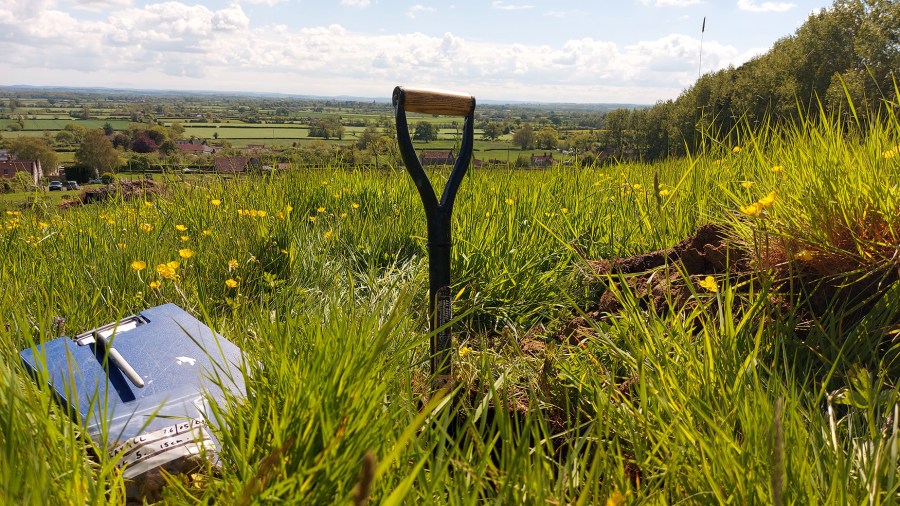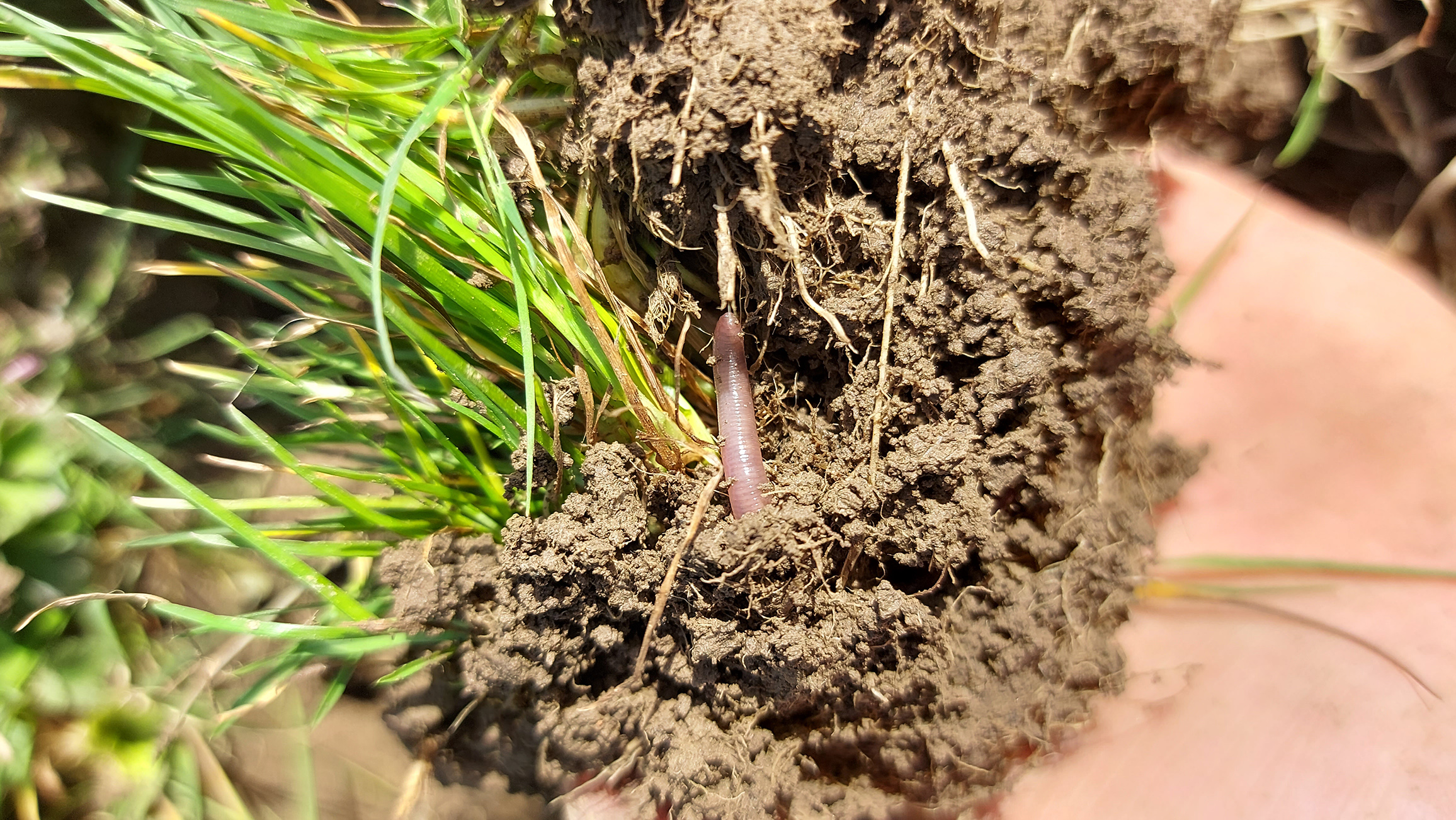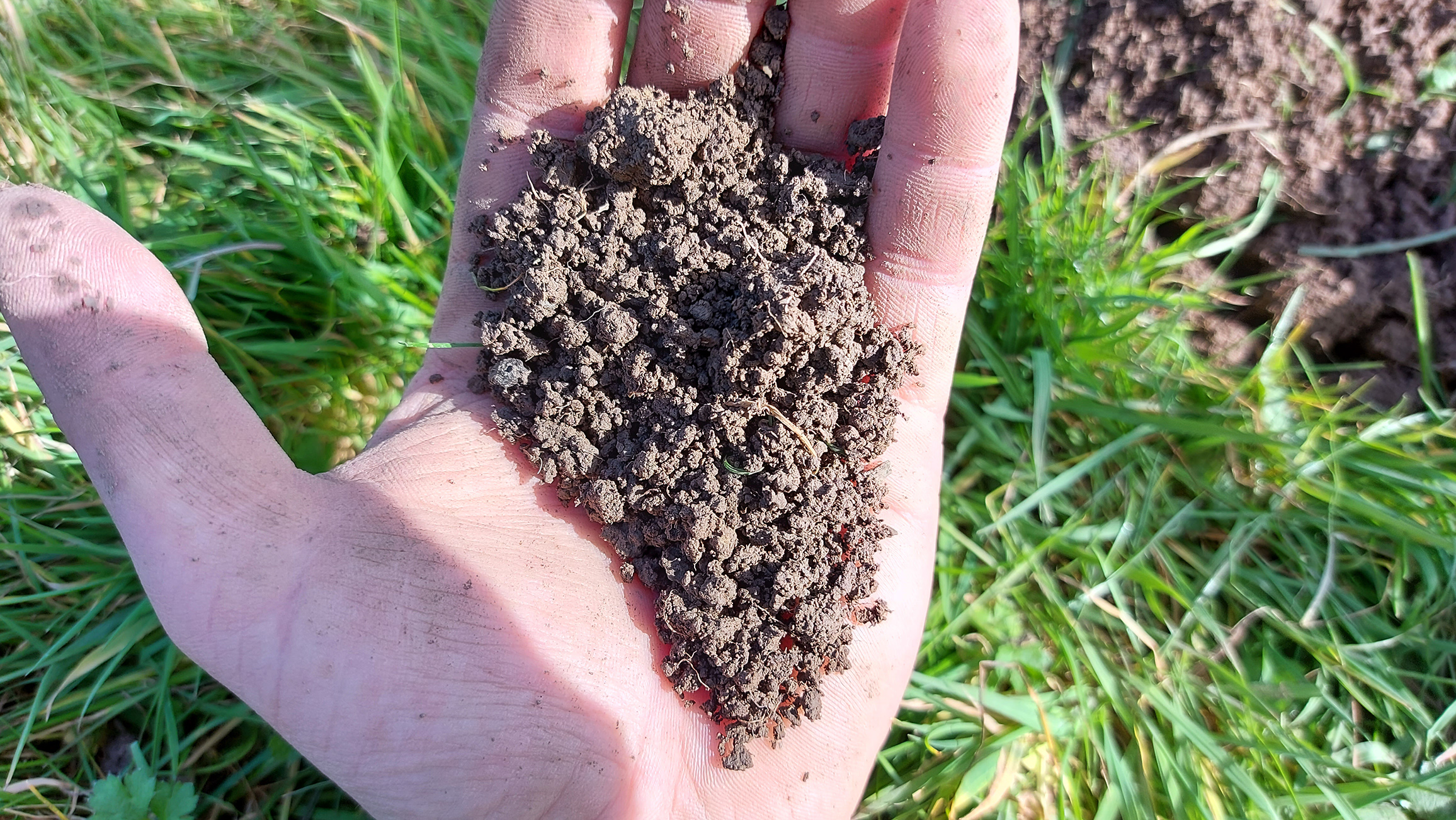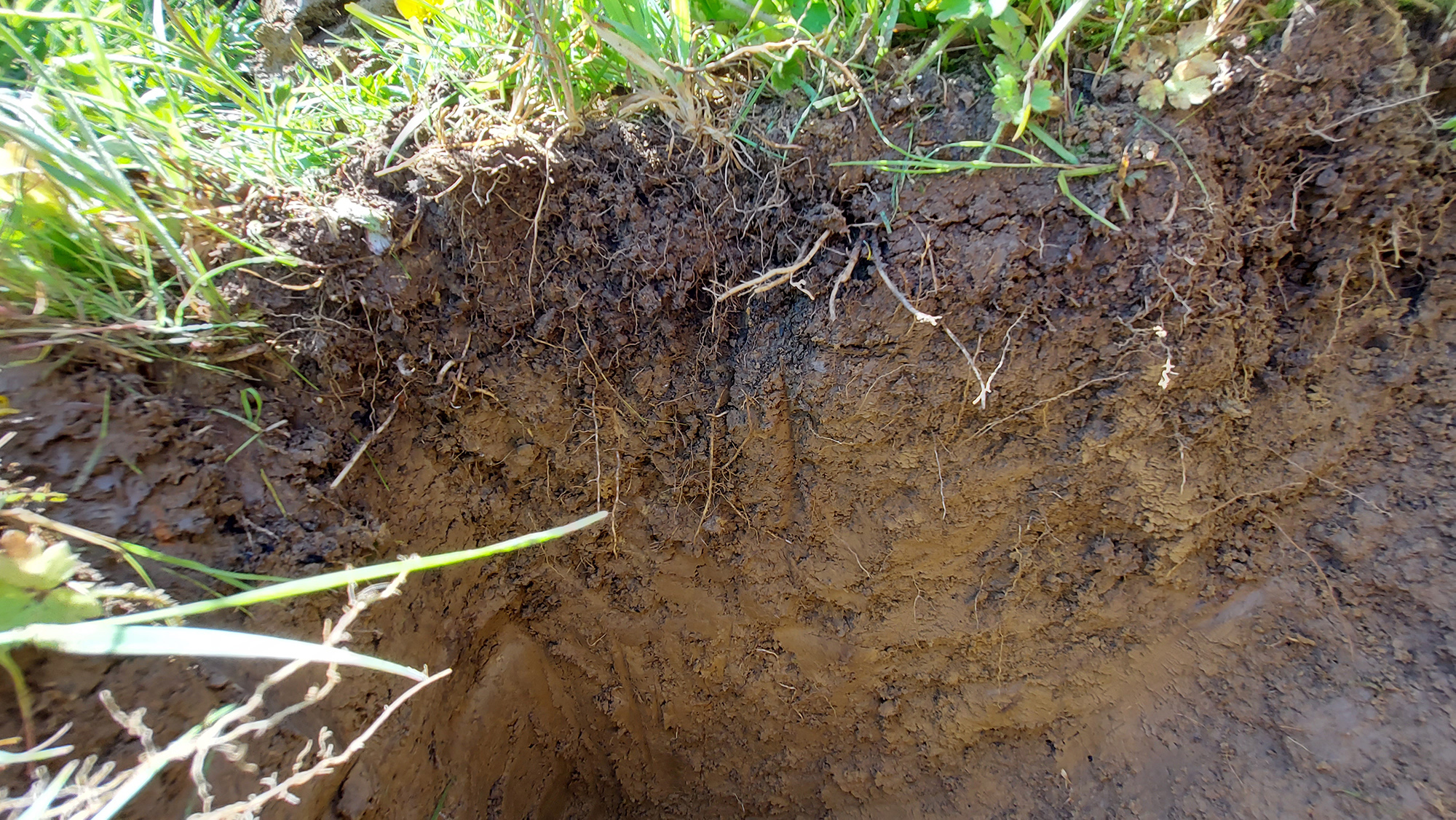Quality grapes are needed for premium wines and the health of the soil is a key factor in achieving this. With much to do in the vineyard during the winter to prepare for the forthcoming season, such as pruning, tying down and trellis repairs – soil is often forgotten. Jo Cowderoy finds out some of the soil management tasks that can be done during the winter dormancy period that will benefit the future crop.
A healthy soil is essential for a sustainable and productive vineyard. Apart from providing physical support to the plant, it supplies nutrients and water for vine growth and berry development. A healthy soil is one maintained in a good condition – biologically, chemically, and physically. Winter soils are easier to dig, so it’s an excellent time for the vineyard manager to get out the spade and collect samples for soil analysis, dig pits to observe drainage and compaction and count worms – a great indicator of soil health.
What is fertility?
The Sustainable Wines of Great Britain (SWGB) bulletin on Soil Management describes soil fertility as being able to sustain plant growth and is defined by nine principal factors: texture, structure, organic matter content, presence of soil organisms, water holding capacity, drainage properties, depth, chemical composition, and acidity. The bulletin suggests there are no standard answers for all vineyard sites, but if in doubt about the performance of the vineyard then it recommends evaluating the current practices for managing the vineyard floor. Looking to minimise soil compaction whilst maintaining or improving the soil structure along with organic matter and biodiversity – then drafting an improvement plan, costing it, and putting it into practice.
Importance of analysis
Mark Botting, Laboratory Manager, Fruit Advisory Services Team LLP (FAST) advises that: “Vineyard managers should be focusing firstly on, triennial soil chemical analysis for pH plus extractable P, K, and Mg, secondly, on annual earthworm counts as an integral part of soil biological health and thirdly on digging soil pits to assess compaction or drainage problems.”
“At FAST we recommend soil analysis every three years to maintain correct pH and nutrient levels,” continued Mark. “Good soil nutrition also plays a part in reducing disease levels. This is in part due to having a healthy active soil ecosystem that can help deal with invading pathogens. The balance of the nutrients is also important especially the K:Mg ratio. The standard UK laboratory soil nutrient test is for pH, plus P, K, and Mg. It is reasonably easy to interpret and directly aids the grower’s fertiliser strategy. This technique uses chemical extractants so only solubilises those nutrients that are available for uptake by the roots so this analysis in effect measures plant-available soil nutrients.
“This methodology of sampling and advice on liming applications and fertiliser use is clearly explained in the AHDB Nutrient Management Guide (RB 209), but an option is to also seek the advice of a FACTS Qualified Advisor especially if your vineyard is in a Nitrate Vulnerable Zone (NVZ).
“The soil pH is probably the most important parameter of all as it has a direct bearing on the availability of all other nutrients. It also has an influence on the activity of the microflora that are so important in making the nutrients available to the plant. At a soil pH of around 6.5 the soluble nutrients in the root zone are at the point of greatest availability to the vine so this is the first thing that should be tackled. Being a fruiting crop, grapevines need a good supply of K so maintaining an optimum level of around 200 mg/l is vital to maintain yield and fruit quality. The K:Mg ratio in the soil should be around 2:1 so Mg levels should be around 100 mg/l and if not applications of Kieserite should be applied (both K and Mg can be added in autumn or spring as long as ground conditions are suitable – but no N should be applied in late autumn and when the vines are dormant) to maintain this ratio as far as possible.
“On chalky soils where the predominant cation is Calcium there is often a deficit of Magnesium and this can cause visible leaf Mg deficiencies in the summer months especially on the older leaves and most often when on a SO4 rootstock. A similar induced Mg deficiency can also be seen if the soil K:Mg ratio gets to 4:1 or above,” added Mark.
“Although many textbooks and agronomists suggest analysing soil only every three years, I like to take samples every autumn,” explained Joel Jorgenson, viticulturist with Veraison. “This helps me track nutrient levels and catch issues before they arise. So much (other than the obvious nutrient status) can be read from a soil analysis if you track changes over time.
“It’s particularly important to keep an eye on soil pH as anything too acidic or alkaline can lock up nutrients, causing them to be unavailable to the vines. Liming to raise the pH to near neutral can take several months to be effective. Small changes are significant as pH is measured on a logarithmic scale – so for example, a pH of 6 is 10 times more acidic than a pH of 7,” added Joel.
“It is imperative to have your soil sampled at least every three years,” commented John Buchan, agronomist. “This will enable you to monitor the nutrient levels in order to optimise their levels and availability – and it makes sense if we accept that around 80% of the vines nutrient requirements are accessed from the soil. The results will require interpreting – to check the levels and ratios in order to decide on actions.
“The soil pH is the most important factor as it controls all nutrient availability. The optimum being between pH 6.8 – 7.2, as we move to either a more acid or alkaline situation so nutrients become progressively locked up in the soil and will be less available to the vine.
“If lime is needed, it should be applied in the autumn to allow it time to start working, as it is a slow-release product. However, if nutrient sulphate formulations are used, they are best applied in the spring as they can be leached through the soil by winter rains,” added John.
The not so lowly earthworm
Although soil health is harder to assess, earthworm numbers are a good indicator of favourable soil conditions as earthworms need moist soils that have sufficient organic matter. Worms are important soil engineers, through their activity they improve soil structure, help create porosity which allows drainage and water movement, as well as nutrient and carbon cycling. Earthworms are affected by soil pH, added to this waterlogging, compaction, and cultivation all reduce their numbers.
“In the vineyard sites we manage, we dig multiple profile pits twice a year to visually assess our soil structure,” explained Joel. “We test the soil’s ‘spade-ability’ (compaction), water infiltration (porosity) and count earthworms. We assess whether the soil aggregates have been built naturally by an active soil food web – such as earthworms, arthropods, fungi bacteria and nematodes, or whether the aggregates are manmade – from cultivators, ploughs, sub-soilers. We record, track, and analyse this data to help us better understand the impacts of every intervention.
“Most soil biology is hard to see with a naked eye, so we use earthworm counts as an easy indicator of biological activity. For the smaller critters, we ask the soil laboratory to count the active fungi and bacteria – interestingly, it seems grapevines prefer a fungal dominant soil,” added Joel.
“The organic status of your soils will allow both maximum nutrient retention and availability,” explained John. “This can be analysed by soil samples, but a good indication can be given by doing a worm count – with four million per hectare being optimal. A high worm count will aid drainage and help to create an aerobic soil – thus allowing good microbial activity and populations,” John added.
“At FAST we also advise annual earthworm counts and digging soil pits as examples of best practice and suggest using the Agriculture and Horticulture Development Board (AHDB) soil assessments and earthworm counts guidance, as well as the LEAF best practice guides to sustainable soils.
“What we really encourage – and this forms part of our one-day School of Fruit Growing Module on Soils and Soil Nutrition – is for growers to regularly assess their soils, not least as a lot of the issues seen in aerial parts of plants can be traced to problems hidden under the soil surface,” said Mark.
Winter cover
Autumn sown cover crops for winter cover are an increasingly common practice. “In the future I foresee an increase in the use of winter cover crops to reduce bare soil percentage, to increase bioavailable nutrients, and to improve soil structure,” commented Mark.
Joel finds that, depending on the results of various soil tests, he may consider sowing a cover crop. “We use a direct drill to do some groundwork for us. However, never drive on waterlogged soil and sow a cover crop mix that’s designed to do what you need. A few strong tap roots, mixed in with adventurous roots can improve drainage and soil aeration far better than any subsoiler or cultivator. As with anything, biodiversity is key to enhancing overall activity in and around the soil, making it work for you, not the other way around. The cover crop should prevent erosion, improve drainage, add organic matter, decrease leaching, feed soil organisms, and generally improve resilience to extreme weather conditions and fluctuations in nutritional demands from your vines.
“I avoid mechanical soil work unless absolutely necessary. Every pass with a machine, slows down the living organisms which would have done the work for you,” added Joel.
“The use of an overwintering cover crop can be of benefit to control weed population, enhance drainage, increase organic matter and encourage beneficial insects,” commented John. “There are a number of cover crop plants that are both deep rooting, for soil improvement, and others with dense growth for weed control,” added John.
“Sub soiling is something that I suggest should be considered for alternate rows each year as a regular soil management operation. However, the challenge is to only do it when the soil conditions are right. The aim is to reduce the compacted wheel tracks thus creating a more aerobic soil profile to allow optimum microbial activity, thus increasing nutrient availability, whilst also aiding drainage.”
Don’t forget that sheep can be a great help in the vineyard over winter to graze off any remaining weeds and grass both within the rows and under the vines – with the added bonus of some fertilizer,” John concluded.
A good crumb-like soil structure
©Joel Jorgensen







